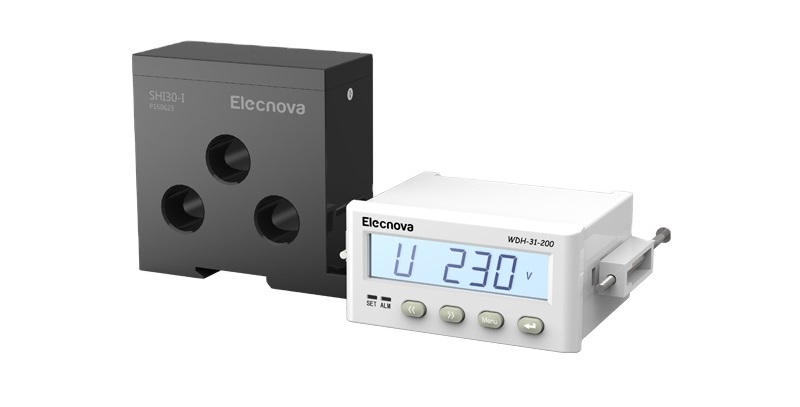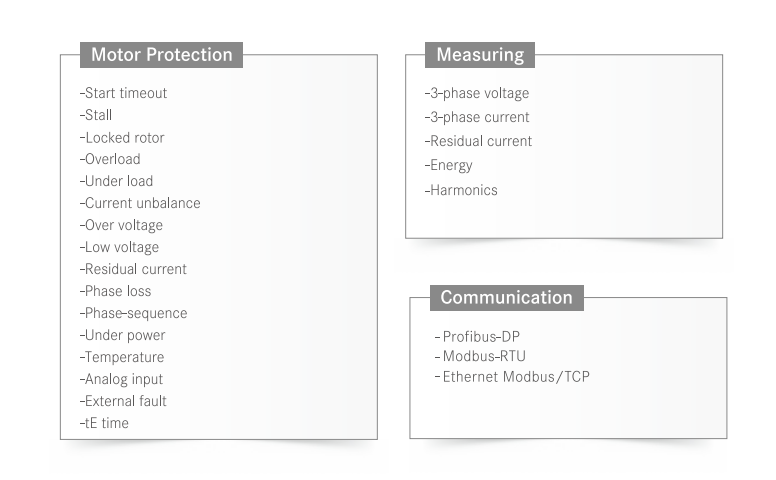.png?v=v1)
.png?v=v1)
2023.05.10
PART 1. The application of the motor
As the power source of the entire industry, motor has shifting the interchange between electric energy and kinetic energy by interaction between electricity and magnetism. It’s widely used by its simple structure, low cost and durability with high efficiency and reasonable performance. Nowadays, motor plays a dramatic important role in the global automation industry. It has great recognition at the metallurgy, electric power, petrochemicals, coal, mining, building materials, paper making industries.
PART 2. Should not be ignored the fault of asynchronous motor
Motors will have various damages such as insulation aging, mechanical damages by the influence of the grid and the load side. The consequence of the motor faults are obvious, they might cause motor damage or burning to increase the maintenance cost or even production break off and decrease the productivity. In some extreme circumstance, security accident may happen.
Let’s focus on two major faults of the motors during they’re running, symmetrical faults and asymmetrical faults. 3 phase short circuit, overload and stall, those account great amount to the symmetrical faults. When the faults happened, the 3-phase current is balance, there is no negative current and zero current as well. But the damage to the motor is bringing heat effect by the enlargement of the current.
On the contrary, 3 phase imbalance, single phase ground connection or phase to phase short circuit are the major phenomena of the asymmetrical faults. When such fault happen, there is no obvious over current, but the negative current increase significantly. So the damage of the motor is the negative sequence effect cause by the negative current, such as terminal over heat of the motor, rotor vibration and decrease of the start torque etc.
Conclusion:
Generally, comparing to the other mechanical devices, motor as one of the most important device in the automation production industry. Ensure the motor continuous operation is the priority of user and the service engineers.
PART 3. How to protect the motor quickly and reliably
How to find out the cause of the motor faults and solve the problems to secure the ordinary work and the performance liability is almost the crucial point and the study direction for the industry. When we looking at the iteration of the motor control devices in the past 2 decades, the developing trend is from a single thermal relay to the integrated intelligent motor protection and control system era.
Thermal relay
The thermal relay is the overload protection component by simple design and cost-effect in a very long time. But the performance and the consistency of the thermal relay is not as stable as it supposed to be by the limitation of the raw materials and the production process, furthermore, the thermal relay was easy to ignore that great amount of heat accumulation which caused by slight overload. In this regard, the aging of motor winding insulation will damage the motor.
Electronic analog protector
As the replacement of the thermal relay, the simple electronic analog motor protector comes out with the micro-processor. It solved the delay protection disadvantage of the thermal relay and increased the protection function as phase loss and ground connection . It also contains the simple display and communication interface particular for the independent motor control box.
Intelligent motor protection and control system
Today, the integrated intelligent motor protection and control system is becoming the best solution of the motor management. It has strong anti-interference ability, highly measuring accuracy, comprehensive protection, programmable control, friendly HMI interface and multiple communication fieldbus interface advantages which makes the smart motor maintenance and management as possible.
Generally, the development of the motor controller pushed the rapid growth of the control cabinet move forward. As the application of the motor controller in the motor control cabinet, the factory MCC were taken place by IMCC which means the control type shifting from the conventional hard wiring to the intelligent fieldbus communication.
PART 4. The core component of the IMCC --- Intelligent motor protection controller
As the core component of the IMCC, the motor controller has the following advantages:
High integration
Comprehensive protection
Flexible logic programming
Emphasizing on the motor management and maintenance
Plenty of fieldbus interface
Let’s go through those advantages one by one
Highly integration
For the single motor circuit, the motor controller integrated measuring, control, management and communication as a compact unit. It eliminated the usage of the intermediate components, such as I/O modular, transducer, relay, button and cables etc. By this reason, it reduced the fault rate of the MCC cabinet and increased the liability and maintain the cost-effect as well.
Comprehensive protection
As can be seen from the previous charts, the motor controller contains greater protection functions. The protection enlargement by voltage and non-electrical protection pays great contribute for the comprehensive motor protection. In particular, the high-speed data acquisition and fast calculation makes the identification of the fault signal and quick response as possible, which is distinct to the conventional thermal relay.
Flexible logic programming
Similar to the PLC, the motor controller is programmable, by this means, the device has various applications. For example, when configure the over current protection logic, you could set the parameters during the start or running process respectively. Furthermore, to control a reversing motor, you could choose to control the D/I or relay functional attributes according to the relevant diagrams. It simplified the wiring and commissioning process.
Management and maintenance
Now, the motor management information is no longer limited at those normal parameters such as start/stop status, voltage, current, power etc. People concerns the power distribution quality of the motor circuit, current and voltage waveform at fault, statistics the wear rate of the contactor. This data could be acquired by the motor controller, it provides a simple and accurate motor management possibility to enhance the use life of the motor.
Plenty of fieldbus interface
The motor controller equipped variety of fieldbus interface, it makes the motor as the essential for the intelligent sensors to the digital factory. Come along with the industry 4.0 era, the conventional fieldbus interface is developing towards to the industrial Ethernet particular at the motor control device.
Conclusion
Now it’s clear that, as the core component of the IMCC, the motor controller is no longer just for the motor control and protection purpose. Its powerful processing ability and plenty I/O interfaces, could not only release the burden of the PLC but also analyze the power quality and the motor status in real time as for the better management to the motors. We believe that when the more and newer technologies, standards and regulations apply on the motor controller, it could be better.
PART 5. The developing trend of the intelligent motor protection controller
Even the functionality of the motor controller is getting mature than before. It contributes perfection to the motor management and control, but to those internal mechanical problems of the motor such as rotor fault, bearing fault, winding fault,the controller could not make a right diagnose and could not estimate the mechanical use life as well. How to make the online monitoring and fault diagnose to the motor device has being the researching direction for years, invasive and Non-invasive are the major directions.
Invasive is monitoring the parameters such as vibration, speed, torque and temperature noise in real time to figure out the fault type and location by install the relevant sensors in advance.
Non-invasive diagnose the motor faults by the current or power spectrum analysis to capture the fault component without install any sensors but only access the motor stator voltage and the current signal.
Apparently, the Non-invasive is simple and economy, it does not require any corrective action to the motor. It’s even better that the hardware of the motor controller available the measurement function by stator voltage, current access. Only by the software algorithm could accomplish the online fault diagnose.
Conclusion
The online fault diagnose is the foundation of the motor protection, it could find out the problems of the motor at the early stage including the internal mechanical fault and electric fault. It’s the extension of the conventional motor protection. How to combine both of them are the hot topic and developing trend for the motor controller.
PART 6. A motor with soft starter or converter still needs a protection controller?
There is no single answer
When we simply looking at the motor control or protection, no matter the soft starter or converter, when the smooth start is finished and switching to the normal running status, the normal protection function is there. In this regard, the motor controller is no longer required. But the digital factory requires a higher standard of the ordinary management and maintenance, such as for a particular motor circuit, the energy consumption data, power quality data, the historical start/running extreme current , start/stop waveform etc. This data is for the better analysis to the device management. The motor controller provides such data. So, even the motor circuit already have the soft starter or converter it could still install the intelligent motor protection controller.
PART 7. Elecnova WDH-31 Series Motor Controller for IMCC
WDH-31-200/210 for basic motor protection

Motor Protection
--Star timeout
--Stall
--Locked rotor
--Overload
--Over voltage
--Low voltage
--Current unbalance
--Residual current protection
WDH-31-530/531 basic motor protection & control

Motor Protection Communication Protocol
--Star timeout --Modbus-RTU
--Stall --Profitbus-DP+Modbus-RTU
--Locked rotor --2CH Modbus-RTU
--Overload --Modbus-RTU+Modbus-TCP/IP
--Over voltage --Modbus-RTU+Profitnet
--Low voltage
--Current unbalance
--Residual current protection
Start Mode Control
--Direct start
--Bi-directional start
--Double speed start
--Y/△ Start
--Resister divider start
--Auto switch start
--Start with soft-starter
--Start with VFD
--Anti voltage sag
Power-on automatic start
WDH-31-500 basic motor protection & control


About Elecnova/Sfere Electric
Elecnova / Sfere Electric a leading manufacturer and solution provider of Power quality analyzer / Energy analyzer / kWh energy meter / Multi circuit power monitoring system / EV charger metering / Digital power meter / Motor controller / Busway temperature sensor / Harmonic Filter / Power factor correction / Low Voltage power distribution panel / Cloud view Power monitoring system.


https://www.sfere-elec.net/product/WDH-31-530-Motor-Protection-Controller-95.html
Copyright © 2019.Company Name All Rights Reserved.